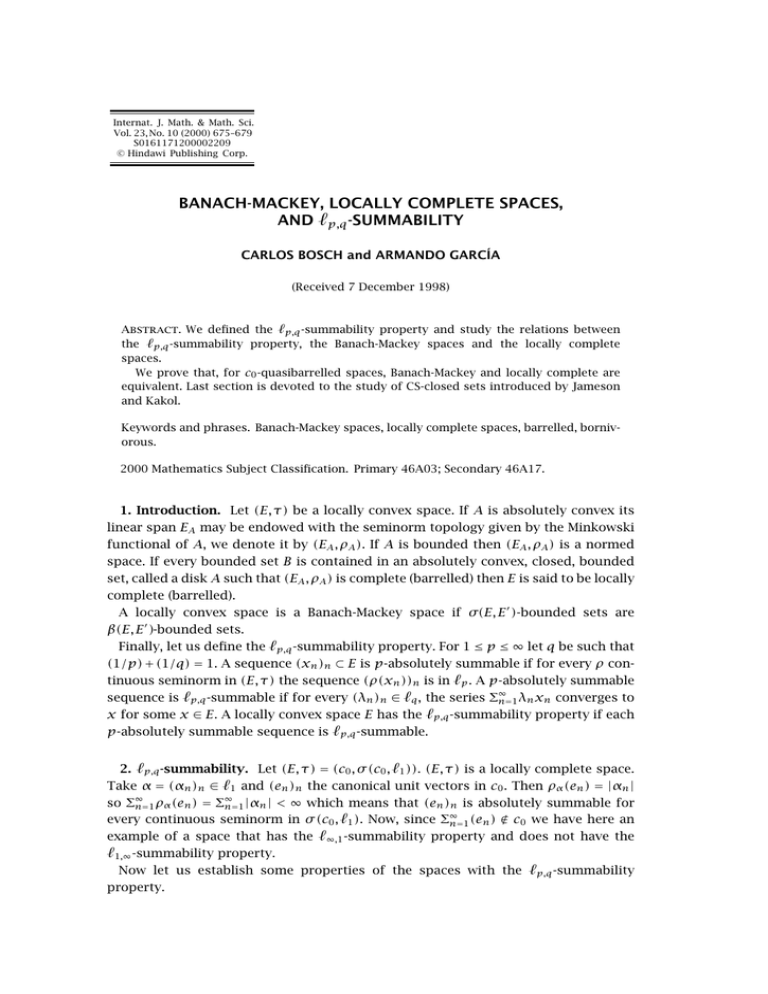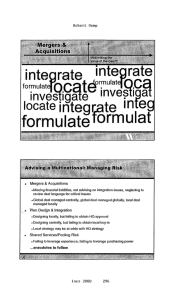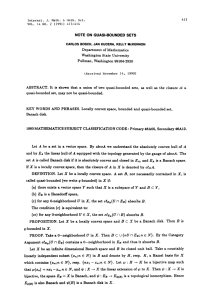Internat. J. Math. & Math. Sci. S0161171200002209 © Hindawi Publishing Corp.
advertisement

Internat. J. Math. & Math. Sci.
Vol. 23, No. 10 (2000) 675–679
S0161171200002209
© Hindawi Publishing Corp.
BANACH-MACKEY, LOCALLY COMPLETE SPACES,
AND p,q -SUMMABILITY
CARLOS BOSCH and ARMANDO GARCÍA
(Received 7 December 1998)
Abstract. We defined the p,q -summability property and study the relations between
the p,q -summability property, the Banach-Mackey spaces and the locally complete
spaces.
We prove that, for c0 -quasibarrelled spaces, Banach-Mackey and locally complete are
equivalent. Last section is devoted to the study of CS-closed sets introduced by Jameson
and Kakol.
Keywords and phrases. Banach-Mackey spaces, locally complete spaces, barrelled, bornivorous.
2000 Mathematics Subject Classification. Primary 46A03; Secondary 46A17.
1. Introduction. Let (E, τ) be a locally convex space. If A is absolutely convex its
linear span EA may be endowed with the seminorm topology given by the Minkowski
functional of A, we denote it by (EA , ρA ). If A is bounded then (EA , ρA ) is a normed
space. If every bounded set B is contained in an absolutely convex, closed, bounded
set, called a disk A such that (EA , ρA ) is complete (barrelled) then E is said to be locally
complete (barrelled).
A locally convex space is a Banach-Mackey space if σ(E, E )-bounded sets are
β(E, E )-bounded sets.
Finally, let us define the p,q -summability property. For 1 ≤ p ≤ ∞ let q be such that
(1/p) + (1/q) = 1. A sequence (xn )n ⊂ E is p-absolutely summable if for every ρ continuous seminorm in (E, τ) the sequence (ρ(xn ))n is in p . A p-absolutely summable
sequence is p,q -summable if for every (λn )n ∈ q , the series Σ∞
n=1 λn xn converges to
x for some x ∈ E. A locally convex space E has the p,q -summability property if each
p-absolutely summable sequence is p,q -summable.
2. p,q -summability. Let (E, τ) = (c0 , σ (c0 , 1 )). (E, τ) is a locally complete space.
Take α = (αn )n ∈ 1 and (en )n the canonical unit vectors in c0 . Then ρα (en ) = |αn |
∞
so Σ∞
n=1 ρα (en ) = Σn=1 |αn | < ∞ which means that (en )n is absolutely summable for
every continuous seminorm in σ (c0 , 1 ). Now, since Σ∞
n=1 (en ) ∉ c0 we have here an
example of a space that has the ∞,1 -summability property and does not have the
1,∞ -summability property.
Now let us establish some properties of the spaces with the p,q -summability
property.
676
C. BOSCH AND A. GARCÍA
Theorem 2.1. Let (E, τ) be a locally convex space. If E satisfies the p,q -summability
property for 1 ≤ p, q ≤ ∞ with (1/p) + (1/q) = 1, then E is locally complete.
Proof. Let A be a bounded set and B = abconv A; B is a disk. Take (xn )n ⊂ EB
a sequence such that (ρB (xn ))n ∈ p . Since i : (EB , ρB ) (E, τ) is continuous, for
every continuous seminorm ρ in E, we have (ρ(xn ))n ∈ p . So for every (an )n ∈ q ,
we have Σ∞
n=1 an xn → x with respect to τ since E has the p,q -summability property.
Now the sequence of partial sums Σkn=1 an xn is ρB -bounded since it is a ρB -Cauchy
sequence as we can see
ρB
k+r
an xn −
n=1
k
k+r
an xn = ρB
n=1
k+1
an xn ≤ an n q · ρB xn
n ,
p
(2.1)
)n =
which is small for k big enough, (an )n = (0, . . . , 0, ak+1 , . . . , ak+r , 0, . . . ) and (xn
(0, . . . , 0, xk+1 , . . . , xk+r , 0, . . . ).
So {ΣK
n=1 an xn : K ∈ N} is a ρB bounded set in (EB , ρB ).
By [5, Theorem 3.2.4] we have that (ΣK
n=1 an xn )K converges to x in (EB , ρB ). So
(EB , ρB ) has also the p,q -summability property.
Now, we will prove the space (EB , ρB ) is complete. Let (xn )n ⊂ EB be an absolutely
summable sequence with xn ≠ 0 for every n ∈ N, so (ρB (xn ))n ∈ 1 then
αn
n
1/p = ρB xn
∈ p ,
n
βn
n
1/q = ρB xn
∈ q .
n
(2.2)
Let yn = xn /ρB (xn ) then (yn )n is ρB -bounded. So (αn yn )n ⊂ EB , (ρB (αn yn )n ) ∈ p
∞
and Σ∞
n=1 xn = Σn=1 αn βn yn converges in (EB , ρB ) since (EB , ρB ) has the p,q summability property so (EB , ρB ) is a Banach disk.
Corollary 2.2. Let (E, τ) be a locally convex space. (E, τ) is locally complete if and
only if (E, τ) has the ∞,1 -summability property.
Proof. Let (E, τ) be a locally complete space and (xn )n ⊂ (E, τ) be a bounded
sequence, so there exists a Banach disk B ⊂ E such that {xn }n ⊂ B and {xn }n is
bounded in (EB , ρB ).
Let (αn )n ∈ 1 , then (αn xn )n is ρB -absolutely summable, that is Σ∞
n=1 ρB (αn xn ) < ∞.
α
x
converges
in
(E
,
ρ
)
so
it
also
converges
in
(E,
τ)
since i : (EB , ρB ) Hence Σ∞
B
B
n=1 n n
(E, τ) is continuous. So E has the ∞,1 -summability property.
Corollary 2.3. E is a Banach space if and only if E is normed and has the p,q summability property.
Proof. We can reproduce the last part of the proof of Theorem 2.1 to show that
E normed and with the p,q -summability property is a locally complete normed space
and so a Banach space.
Now suppose E is a Banach space and denote the norm by . Let (xn )n ⊂ E be a
sequence such that (xn )n ∈ p and let (βn )n ∈ q then the sequence (βn xn )n is
absolutely summable that is
BANACH-MACKEY, LOCALLY COMPLETE SPACES, AND p,q -SUMMABILITY
∞
βn xn ≤
n=1
∞
n=1
1/p
p
xn
∞
677
1/q
q
βn <∞
(2.3)
n=1
hence summable, since E is a Banach space so E has the p,q -summability property.
3. Banach-Mackey space
Definition 3.1. E is a c0 -barrelled (c0 -quasibarrelled) space if each null sequence
in (E , σ (E , E)) ((E , β(E , E))) is E-equicontinuous.
Note that a c0 -barrelled space is a c0 -quasibarrelled space.
Lemma 3.2. If (E, µ(E, E )) is a Banach-Mackey space, where µ(E, E ) denotes the
Mackey topology, and c0 -quasibarrelled space then it is a c0 -barrelled space.
Proof. Let A ⊂ (E , σ (E , E)) be a bounded set, since E is a Banach-Mackey space,
E is also a Banach-Mackey space (cf. [9, Theorem 5, page 158]), and then A is β(E , E)bounded so it is contained in a bounded Banach disk by [2, Observation 8.2.23],
since the space is c0 -quasibarrelled. Then by the same observation we have that
(E , σ (E , E)) is locally complete.
Corollary 3.3. (E, µ(E, E )) is c0 -quasibarrelled and Banach-Mackey if and only if
(E , σ (E , E)) is locally complete.
Proof. Necessity follows from previous lemma and [2, Observation 8.2.23]. The
other implication follows from the same observation, the note following Definition 3.1
and the fact that by [7, Corollary 3, Theorem 1] we have that (E , σ (E , E)) locally
complete implies (E, µ(E, E )) is a Banach-Mackey space.
Following Saxon and Sánchez [8], a space E is dual locally complete if (E, σ (E , E))
is locally complete; then we can extend the result shown in [8, Theorem 2.6].
Corollary 3.4. (E, µ(E, E )) is dual locally complete if and only if it is BanachMackey and c0 -quasibarrelled.
A locally convex space E is quasibarrelled if each barrel that absorbs bounded sets
is a neighborhood of zero in E. It is clear that a barrelled space is quasibarrelled, in
certain cases they are equivalent.
Note that using [7, Theorem 1] we can easily prove that: a locally convex space E is
quasibarrelled and Banach-Mackey if and only if it is a barrelled space. Next proposition summarizes what we know about Banach-Mackey spaces in the case of quasibarrelled spaces.
Proposition 3.5. Let (E, τ) be a locally convex quasibarrelled space, then the following properties are equivalent:
(a) E is a Banach-Mackey space.
(b) E is a Banach-Mackey space.
(c) E is barrelled.
(d) E is semireflexive.
(e) In E , abconv K is compact for each K ⊂ E compact.
678
C. BOSCH AND A. GARCÍA
(f) For every xn → 0 in E and every (αn )n ∈ 1 , Σ∞
n=1 αn xn → x for some x ∈ E .
(g) E is locally complete.
(h) E is locally barrelled.
Proof. (a) ⇒(b) using [9, Theorem 5, page 158]. (b) ⇒(c) from the previous note.
(c) ⇒(d) by [9, Theorem 4, page 153]. (d) ⇒(e) is obtained using the same theorem and
the fact that a convex hull of a compact set is totally bounded together with [9, Exercise 5, page 122]. (e) ⇒(f) by [7, Theorems 2 and 3]. (f) ⇒(g) using [3, Proposition III.1.4]
and [2, Theorem 5.1.11]. (g) ⇒(h) is trivial. (h) ⇒(a) using [1, Theorem 1].
Note that (f) and (g) are equivalent in general, [3, Proposition III.1.4] and [2, Theorem 5.1.11] prove (f) ⇒(g) and do not assume E is quasibarrelled, and the other
implication can be obtained using an argument similar to the one in Corollary 2.2.
4. CS-closed sets. In this section, we give a more precise definition of the convex
series and their properties, first studied by Jameson [4] and Käkol [6].
Definition 4.1. Let (E, τ) be a locally convex space.
∞
(a) Let A ⊂ E, (an )n ⊂ A and (cn ) ⊂ [0, 1] such that Σ∞
n=1 cn = 1 if Σn=1 cn an is
convergent we say that it is a convex convergent series of elements of A.
(b) A ⊂ E is CS-closed if each convex convergent series of elements of A belongs
to A.
(c) A ⊂ E is CS-compact if each convex series of elements of A converges to an
element of A.
(d) A ⊂ E is ultrabounded if each convex series of elements of A is convergent in E.
(e) The CS-closure of A is the intersection of all CS-closed sets that contain A.
Observation. (i) An ultrabounded set is bounded.
(ii) The intersection of CS-closed sets is a CS-closed set.
For convenience let us introduce another definition.
Definition 4.2. (a) B ⊂ E is called a CS-barrel if it is absolutely convex, absorbent
and CS-closed.
(b) E is a locally CS-barrelled (barrelled) space if for each bounded set A ⊂ E there
exists a disk B such that A ⊂ B and EB is a CS-barrelled (barrelled) space, that is that
each CS-barrel (barrel) is a neighborhood of zero.
Now several properties of barrels also hold for CS-barrels although the last sets are
somehow “smaller” than the first sets.
It is clear that if E is a CS-barrelled space then it is a barrelled space.
Now if (E, τ) is locally barrelled, then for each bounded set A ⊂ E there exists a
closed bounded disk B such that A ⊂ B ⊂ E and (EB , ρB ) is barrelled, so for each CSbarrel U in EB , U is a barrel so it is a zero neighborhood with respect to ρB , since
(EB , ρB ) is metrizable by [4, Theorem 1], U is also a zero neighborhood with respect
to ρB . So we have proved the following.
Proposition 4.3. (E, τ) is a locally barrelled space if and only if it is locally CSbarrelled space.
BANACH-MACKEY, LOCALLY COMPLETE SPACES, AND p,q -SUMMABILITY
679
The CS-compact hull of a set A is the set of convex convergent series of its elements.
A is CS-compact if each convex series of elements of A converges to an element
of A, so we have that the CS-compact hull of a set is not necessarily a CS-compact set.
This is the moment to bring in the ultrabounded sets, since the CS-compact hull of an
ultrabounded set is a CS-compact set.
Proposition 4.4. In a locally convex space (E, τ), CS-barrels absorb ultrabounded
sets.
Proof. Let W be a CS-barrel and A an ultrabounded set in E. Let D be the balanced
CS-compact hull of A, by [6, Corollaries 2–4] D is a Banach disk so ED is barrelled,
τ
and the identity map i : ED → E is continuous so W ∩ ED is a barrel in (ED , ρD ),
τ
furthermore it is a neighborhood of zero in ED , so A ⊂ D ⊂ λW ∩ ED for some λ > 0.
Now for (xn )n ⊂ W ∩ ED and (an )n ∈ [0, 1], with Σn an = 1 such that Σn an xn → x in
(ED , ρD ), since W is a CS-barrel in (E, τ), we have Σn an xn → x in (E, τ) and x ∈ W ,
τ
then x ∈ W ∩ED and it is a CS-barrel in (ED , ρD ). By [4, Theorem 1], W ∩ED and W ∩ED
have the same interior with respect to ρB , so A ⊂ D ⊂ λ(W ∩ ED ) ⊂ λW .
Remark 4.5. Since every Banach disk is ultrabounded (cf. [6, Proposition 2.2]) then
each CS-barrel absorbs Banach disks.
To close this section let us mention that if E is locally barrelled then each CS-barrel
is a bornivorous (see [7, proof of Theorem 2(1)]).
Acknowledgement. The first author was partially supported by Fulbright grant
# 22799 and by the Asociación Maxicana de Cultura A. C.
References
[1]
[2]
[3]
[4]
[5]
[6]
[7]
[8]
[9]
C. Bosch, T. Gilsdorf, and J. Kučera, A necessary and sufficient condition for weakly bounded
sets to be strongly bounded, An. Inst. Mat. Univ. Nac. Autónoma México 28 (1988),
1–5 (1989). MR 91c:46005. Zbl 91c:46005.
P. P. Carreras and J. Bonet, Barrelled Locally Convex Spaces, North-Holland Publishing Co.,
Amsterdam, 1987. MR 88j:46003. Zbl 614.46001.
M. de Wilde, Closed Graph Theorems and Webbed Spaces, Pitman (Advanced Publishing
Program), Boston, Mass., 1978. MR 81j:46013. Zbl 373.46007.
G. J. O. Jameson, Convex series, Proc. Cambridge Philos. Soc. 72 (1972), 37–47. MR 47#772.
Zbl 235.46019.
H. Jarchow, Locally Convex Spaces, B. G. Teubner, Stuttgart, 1981. MR 83h:46008.
Zbl 466.46001.
J. Kakol and H. Konig, Ultrabounded and σ -Convex Sets and Regularity of (LF)-Spaces, to
appear.
J. Qiu and K. McKennon, Banach-Mackey spaces, Internat. J. Math. Math. Sci. 14 (1991),
no. 2, 215–219. MR 92b:46002. Zbl 821.46002.
S. A. Saxon and L. M. Sánchez Ruiz, Dual local completeness, Proc. Amer. Math. Soc. 125
(1997), no. 4, 1063–1070. MR 97g:46004. Zbl 870.46001.
A. Wilansky, Modern Methods in Topological Vector Spaces, McGraw-Hill International Book
Co., New York, 1978. MR 81d:46001. Zbl 395.46001.
Bosch: Departmento de Matemáticas, ITAM, Rio Hondo #1, 01000 México D. F., Mexico
E-mail address: bosch@itam.mx
García: Instituto de Matemáticas, Zona de la Investigacion Científica, Circuito Exterior, Ciudad Universitaria, 04510 México D. F., Mexico



